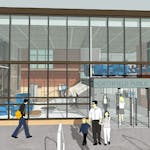The Minnesota Zoo is showing its age.
Railings and bridges are flaking with rust. Walkways are marred by fissures. And zip-ties are holding together bits of deteriorating mesh in the Tropics Trail Aviary.
"When you walk in, you can see crumbling concrete and grass growing out of cracks in the sidewalk. Those are things that impact guest perception," said trustee Peter Maritz. "We want it to look new and shiny."
The zoo is in the midst of an intense lobbying campaign for its nearly $35 million bonding bill request, which asks the Legislature to fund an aerial walkway, a trolley system and critical infrastructure improvements at its 40-year-old Apple Valley campus.
Director John Frawley has taken a more measured approach to long term planning than his predecessor, Lee Ehmke, a famed exhibit designer who liked to dream big. Rather than launching pricey blockbuster exhibits, Frawley has shifted focus toward more bite-sized investments that slowly revitalize what the zoo already has to offer. He hopes the change will result in more buy-in from a polarized Legislature that has shown little enthusiasm for a huge expansion project. (Last year, the zoo received only $4 million of its total $24 million request.)
Basic maintenance, Frawley stressed, is imperative to keeping the zoo viable and preventing safety issues down the road. "If we don't get ahead of this, it's going to be a problem for us," Frawley told the zoo's board of trustees on Tuesday night. "Once it gets to a certain point, you can't catch up."
To garner financial support, zoo officials have produced promotional videos of the state agency's grounds and animals. One 4.5-minute video flashes scenes ranging from the zoo's 1978 opening to today, utilizing treetop-clearing drones to illustrate the evolution of a "world class" destination. "Its value to the state and its people is undeniable," says a deep-voiced narrator, who touts the agency's conservation work. "The integrity of this Minnesota jewel is at stake if we don't act now."
Zoo administrators have also led tours of the sprawling property for the House Bonding Committee, Republican House members and Gov. Mark Dayton's staff.
The fundraising push comes amid sweeping changes to the zoo's strategic plan, which emphasizes connecting guests with nature. The most ambitious plans involve converting the defunct monorail track into an aerial treetop walk — thought to be the first of its kind at an American zoo.
Repurposing the 1980s-era track into a boardwalk — like New York City's popular High Line park — would provide a new viewing experience.
Officials initially hoped to pay for the project with private donations, but the zoo has asked for $5 million from the state to get started. Also included in the $34.75 million bonding request: $13.75 million for asset preservation to address a backlog of crucial repairs that update animal holding areas, replace asphalt pathways and update 40-year-old mechanical systems; $4 million to reopen the popular nocturnal exhibit that closed in 2008; and $2.5 million to fund mobilization, making the zoo more accessible via trolley.
Frawley admits the most common complaint about the zoo is that it's difficult to navigate on foot. As a result, fewer older adults make the trek.
"If you pull in one of our parking lots and try to get to the [Wells Fargo Family Farm] with grandma, then that's not a good day," he said.
Ultimately, Frawley hopes the nearly 500-acre property will become a gateway to Minnesota's beloved state parks by promoting a growing selection of outdoor activities.
A broader 10-year, $150 million master plan that envisions adding campgrounds, hiking trails and an adventure course to the zoo is expected to be unveiled by year's end. Executives will spend approximately $250,000 to commission the document.
Liz Sawyer • 612-673-4648
![The defunct monorail track passes above the Hanifl Family Wild Woods Play Area as seen Thursday afternoon. ] AARON LAVINSKY ï aaron.lavinsky@star](https://arc.stimg.co/startribunemedia/5LG5GKIGY3OT2YHVB7X3VJDW7E.jpg?fit=crop&crop=faces&w=550&&auto=format)



![The scene around bar close in downtown Minneapolis early Saturday morning. ] Aaron Lavinsky ¥ aaron.lavinsky@startribune.com Steve Fletcher wants](https://arc.stimg.co/startribunemedia/IADMQGKJPV34D5DKFS2EO2XKOQ.jpg?w=75&h=75&fit=crop&crop=faces)
